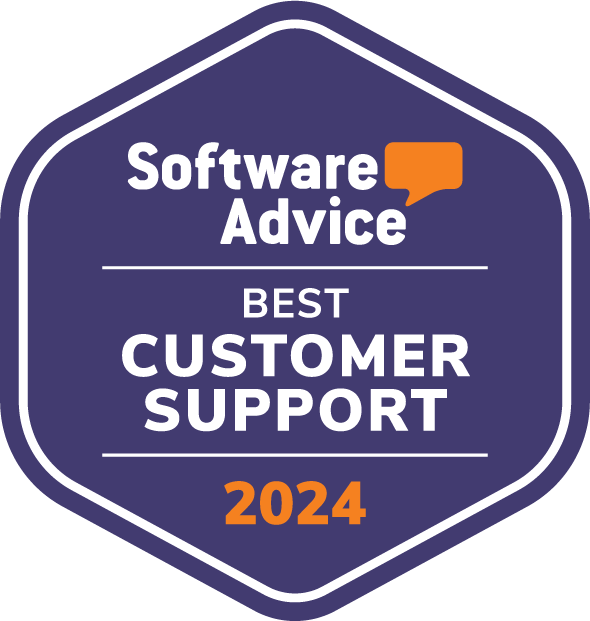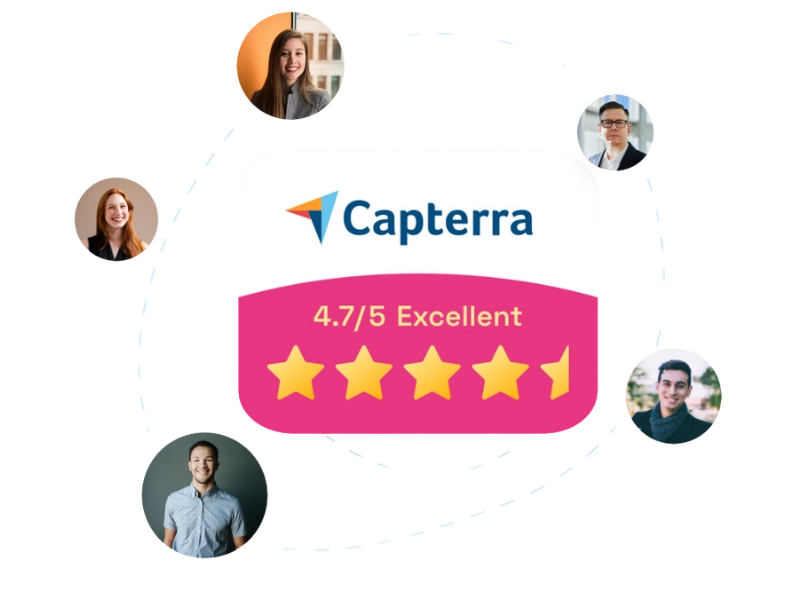Smarter Than Chatbots? Implementing Intranet Digital Assistants
For the intranet and, more generally, to digitalize internal processes, is it better to adopt a chatbot or a digital assistant? What is the difference between these two technologies based on artificial intelligence?
We can say that a chatbot is limited to providing predefined answers based on its knowledge base, while a digital assistant is capable of understanding the business context. This enables it to interpret user needs, provide timely responses by accessing digital workplace data, and suggest concrete actions to improve productivity.
In this article, we will explore in detail what a digital assistant is, what it can do within your digital work environment, and how to implement it in the simplest way, also through the adoption of Gaia by intranet.ai.

Intranet Digital Assistant: What is it and why you need it?
A digital assistant for the intranet is a software solution powered by artificial intelligence that operates within an organization’s internal network, enabling staff to interact with corporate data and speed up their tasks.
Often mistaken for a chatbot, assistants go far beyond a simple chat: thanks to natural language processing and machine learning capabilities, they can:
- understand questions, requests, and commands expressed in conversational language;
- interpret the context in which the conversation takes place;
- provide helpful answers based on the user’s actual needs.
The most compelling aspect of this technology is its ability to integrate with enterprise systems and knowledge bases, such as CRMs, HR platforms, help desks, document repositories, and so on. In practice, a digital assistant can become the single point of access to internal information and services, avoiding fragmented searches or continuous navigation through different intranet sections.
Before the rise of AI, retrieving useful information often meant browsing through countless pages of content. Now, it's enough to ask something like "Where can I find the standard contract for new suppliers?" or "How do I report a PC malfunction?" and the assistant will immediately provide the most relevant materials, along with any helpful tips on how to use them.
The ability to understand natural language is what makes interacting with a digital assistant feel so intuitive. For example, you might write "I need the onboarding procedure for new remote-working colleagues" and, instead of having to remember where that document is stored, the assistant will search through databases, FAQs, and pages of the corporate knowledge base, returning the file’s location or sharing it directly.
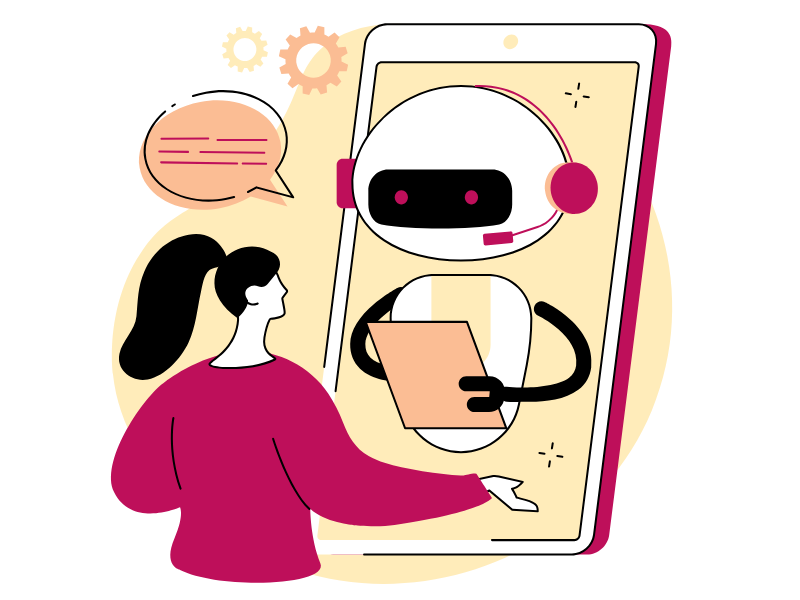
Adopting a technology like this is important for a company not only because it reduces search time and speeds up internal operations, but also because it helps create a more dynamic ecosystem focused on the real needs of everyone within the organization.
Its value brings benefits mainly in five areas, which are briefly summarized in the table below.
| Benefits of a digital assistant | Description |
| Support for productivity | By delegating the most common operational tasks, such as booking meeting rooms, answering FAQs, or managing tickets, to the assistant, employees gain time to focus on more important tasks. This means fewer distractions, less stress, and better work organization. |
| Improved employee experience | Getting the needed answers right away, without navigating through web pages, emails, or internal calls, makes daily tasks easier to complete. This seemingly simple feature significantly impacts employee satisfaction by providing a tool designed around their needs. |
| Onboarding | A digital assistant can provide tutorials, guidelines, and training resources. If a new hire doesn’t know how to request time off or join an initiative, they can simply ask the assistant instead of wasting time searching for this information or waiting for a reply from senior colleagues. |
| Automation of repetitive tasks | For departments like IT or HR, which often deal with the same types of requests, a digital assistant can automate responses to common questions or speed up access to the relevant information, easing their workload. |
| Driving digital transformation forward | Adopting a digital assistant promotes a company culture more open to emerging technologies, while also supporting digital transformation with a greater likelihood of successfully integrating additional tools, whether AI-powered or not. |
In essence, a well-designed and properly integrated digital assistant can significantly strengthen the intranet’s role in helping the organization grow.
A direct impact can be seen in terms of knowledge management.
By interacting daily with people across the organization, the assistant collects valuable data on which content is most frequently searched, which issues recur, and which gaps prevent employees from performing at their best.
This information, processed into insights, allows the company to identify areas for improvement and guide strategic decisions, such as redefining inefficient workflows or designing targeted training programs.
In this way, a digital assistant not only improves access to information, but actively contributes to the optimization of internal processes.
Key features of an AI assistant for the intranet
When it comes to the features that define a digital assistant for the intranet, the goal is to highlight how this technology can transform the digital workplace, especially when built on Microsoft 365 and SharePoint Online.
We’re not talking about simply integrating a support chat.
A digital assistant, in fact, offers a variety of advanced tools that span every aspect of corporate life, from document search to defining new strategies for productivity, employee experience, and, consequently, organizational growth.
This is where Microsoft 365 and SharePoint Online prove to be ideal platforms for building an integrated intranet and digital workplace, as they provide the assistant with a rich, synergistic data ecosystem and powerful automation capabilities.
Let’s start with how easy it becomes to access information.
Every organization generates and stores files, procedures, and documents daily, often organized into various libraries and folders. While a traditional intranet can offer some structure, finding the needed information may take time, and requires employees to remember exactly where a file is stored or who manages a specific project.
A digital assistant leverages its natural language understanding capabilities to interpret user queries and search internal databases (only if it has direct access through specific APIs, such as Microsoft Graph for SharePoint lists and libraries), returning the desired information instantly.
The idea is to simplify the experience.
Instead of navigating across multiple sites or apps, users can ask the assistant things like "Show me the latest version of the XY supply contract" and receive the corresponding document within seconds.

Overview of how Microsoft Graph works
Let’s move on to personalizing the user experience.
Unlike outdated, lengthy, and static FAQ pages, a digital assistant can leverage machine learning algorithms and integration with Microsoft Graph to understand each user’s role, preferences, and interests.
For example, a colleague in the sales department might be shown updated documents on commercial strategies or discount policies. New hires, on the other hand, could be offered tutorials and setup instructions for company tools.
The assistant could even remind users of deadlines or appointments by accessing Outlook calendar data, or suggest participation in specific events based on their role or interests.
Another key strength lies in process automation.
Modern intranet solutions (like the one offered by intranet.ai) aim to reduce the time and effort spent on repetitive tasks, such as gathering information, filling out forms, or periodically updating data. By integrating Power Automate with SharePoint Online, a digital assistant can trigger workflows starting from a simple text input.
For instance, if an employee needs to report an issue to the IT team, they can simply inform the assistant, which will then create a ticket in a SharePoint list, notify the responsible technician via Microsoft Teams, and track the status of the request.

Automatic notifications in Teams to share news from the SharePoint intranet by intranet.ai
It’s worth emphasizing that a digital assistant also proves valuable in supporting specific departments, such as Human Resources. Think of a colleague who wants information about their vacation balance, smart working policies, or how to request special leave. Instead of browsing through endless procedures or waiting for HR to reply, they can ask the AI directly: "How many vacation days do I have left this year?" or "How can I request extraordinary leave?"
If the information is already stored in a database integrated with Microsoft 365, the assistant will retrieve it instantly. If the request is more complex, it can initiate a formal approval process to obtain the necessary authorizations.
Naturally, these features wouldn’t have the same value without a solid foundation of data integration. This is where SharePoint Online comes into play, as it can host document libraries, custom lists, informational pages, and even content management systems like Microsoft Syntex technologies in SharePoint Premium.
By interacting with these repositories, the assistant becomes a central point of convergence. What does that mean? Unlike a standard text search based on generic keywords, the assistant can interpret the context of a question or command, aggregating information from multiple sources.
This provides a 360-degree view. For example, in response to "Show expired contracts related to European suppliers," the artificial intelligence is capable of combining metadata, expiration dates, and location data to deliver a complete list.
Within Microsoft 365, there are several apps and services that further enrich this experience:
- Viva Engage for building an internal social network;
- Viva Insights to receive data and tips on personal productivity.
The AI can interact with these modules to:
- remind users of important events;
- suggest completing a task related to a goal;
- recommend scaling back workload to avoid burnout.
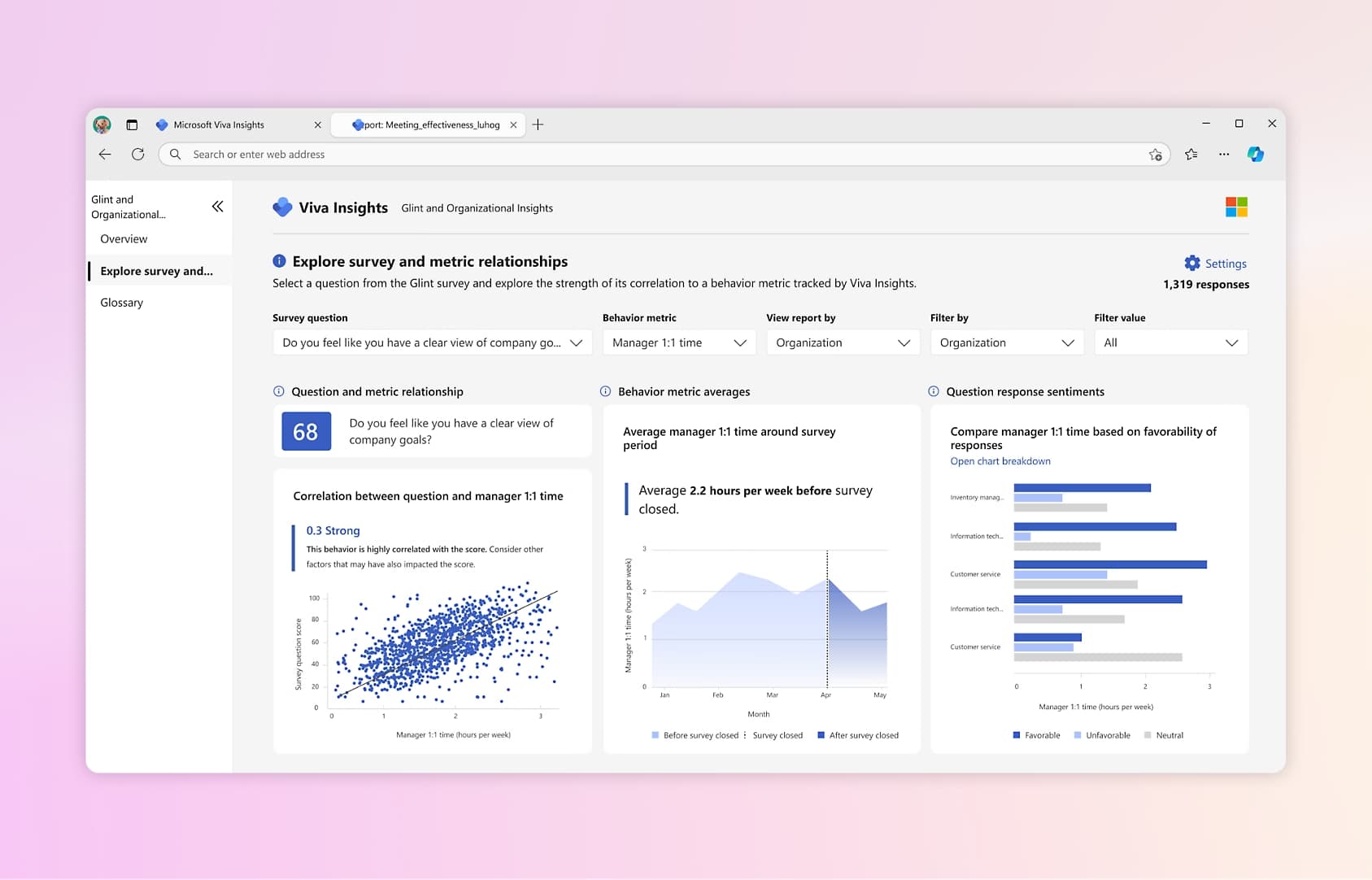
Overview of the data provided in Viva Insights
Another often-overlooked advantage is the ease of adoption.
If the corporate intranet is already based on Microsoft 365, adding a digital assistant does not necessarily require a radical overhaul of the existing structure.
Many AI solutions for Microsoft 365 offer pre-built connectors and ready-to-use APIs, allowing seamless integration between the assistant and individual features of SharePoint, Teams, Outlook, and the rest of the suite, without having to develop the ecosystem from scratch.
This modular approach simplifies the testing phase and the subsequent rollout across business areas. In practice, it’s advisable to start with a small pilot group to assess results, and only then scale the solution company-wide.
Finally, let’s not forget about data security.
This is a key strength when the assistant operates within Microsoft 365, as it inherits the compliance and security policies defined at the tenant level. In other words, the assistant will never provide information to a user who isn’t authorized to view it, and all conversations are handled in accordance with privacy standards and compliance rules applied across the corporate ecosystem.
Intranet Digital Assistant: How to implement it?
Introducing an AI system for the intranet requires careful planning that involves people, processes, and infrastructure. There’s a risk of investing time and resources into creating a simple bot with no real use, or starting a fragmented project.
A structured path is needed to enable a smoother adoption process. In the table below, we offer a few suggestions to successfully integrate a virtual assistant into your digital workplace, with a focus on what truly matters: simplifying employees’ work, reducing inefficiencies, and enhancing the value of your company’s intranet solution.
| Implementation phase | Description |
| Define a roadmap | The first step? Outline the project scope by identifying what you want the assistant to achieve. Some examples: answer employee questions, retrieve documents, manage leave requests, or act as first-level IT support. Implementing an assistant just because "AI is trendy" leads nowhere. Instead, focus on the value it can bring to organizational productivity to gain clear direction. |
| Map existing data and processes | A virtual assistant performs best when it can connect to existing company knowledge bases and trigger automated workflows. Start by analyzing current content: where are the most consulted documents stored? Which procedures are most requested? How are FAQs archived? Understanding how employees interact with the intranet will help identify improvement opportunities. |
| Create a smooth conversational experience | The dialogue model is crucial for usage and adoption: how does the assistant introduce itself to employees? Typically, suggestions are provided to guide users in their first interactions. Don’t forget the tone: formal? Informal? A mix of both? |
| Identify automation opportunities | How often do we interact with conversational AI and feel unsatisfied with the answers? A digital assistant that only returns text responses isn’t very useful, especially in the workplace. It needs to be able to perform concrete actions. If a colleague wants to open a ticket, the assistant should be able to generate the request using help desk system integration. The ability to interact with existing enterprise systems is key to automating time-consuming processes. |
| Test before global rollout | A pilot project involving a small group of users allows the collection of interaction data and helps identify weak points. Adoption should be gradual; otherwise, there’s a risk of providing a tool that holds little value for employees’ day-to-day work. |
| Train employees | A digital assistant isn’t always intuitive to use, even when available to everyone in the organization. Employees must understand when and how it can help. To clarify the value of this technology, it’s recommended to organize an internal communication campaign along with dedicated training sessions. This helps promote the new assistant, generate engagement, and lay a strong foundation for effective AI use. |
| Keep improving performance | The project doesn’t end with the assistant’s launch. Every interaction generates valuable data that can be analyzed to identify usage trends, critical issues, and opportunities for improvement. If users often ask questions the assistant can’t answer, consider reorganizing the knowledge base. If one feature is used more than others, you might develop extensions to enhance it. If the assistant is mainly used for specific tasks, like booking meeting rooms, you could add complementary features such as ordering catering or notifying attendees automatically. |
Returning to the Microsoft 365 ecosystem, Microsoft Mesh introduces a new dimension in using digital assistants within the corporate intranet, transforming text-based interaction into a more immersive experience.
Mesh acts as a platform for creating collaborative 3D spaces, where a digital assistant can serve as an interactive guide. These are environments where employees can interact with the assistant using voice commands, gestures, or visual interfaces.
With Mesh, the assistant can appear as an avatar inside a virtual office, ready to answer users’ questions. No more browsing through pages and folders: the AI identifies the needed file and projects it into a three-dimensional environment, making it easy to view together with colleagues.

Overview of an environment created with Microsoft Mesh
But how can this technology be implemented?
The integration in Microsoft Mesh is carried out through the use of Microsoft Bot Framework and Power Virtual Agents, tools that allow the creation of conversational assistants capable of interacting with enterprise platforms.
These AI solutions are connected to Microsoft Graph, the system that links all Microsoft 365 applications (including SharePoint Online, Teams, Outlook, and Viva). This enables an assistant to access real-time data from the digital workplace and provide responses based on always up-to-date information.
Mesh also benefits from integration with Azure Cognitive Services, a suite of artificial intelligence tools that allows virtual assistants to understand natural language, recognize user intent, and respond contextually. For example, if a manager requests a performance summary of their team, an assistant can retrieve the data from Power BI and present it as a chart.
From a technical standpoint, the company must configure Mesh and connect it to its resources.
This is done through the Microsoft Graph APIs, which allow the digital assistant to access data stored in internal systems. Additionally, Azure Active Directory (now called Entra ID) can be used to manage access permissions, ensuring that each user can only view the information they are authorized to access.
Intranet Digital Assistant: Who is Gaia from intranet.ai?
Today, companies are no longer satisfied with simple virtual spaces for sharing information. They seek platforms capable of interpreting data, anticipating employee needs, and supporting real-time collaboration, especially with the growing number of distributed teams.
They’re looking for more sophisticated AI solutions for their intranet.
Gaia Intranet Manager, developed by our team, stands out as one of the best solutions to enhance SharePoint with the intelligence of Microsoft Copilot and the capabilities of Intranet Analytics.
Just ask "What are the most searched keywords on the intranet this month?" or "How can I improve intranet search?" to trigger an analysis process that goes far beyond simply reading search logs.
Gaia detects trends, content gaps, and optimization opportunities, providing recommendations on how to best organize information, set metadata, and update outdated content.
On top of that, Gaia monitors user behavior while they browse, categorizing data by role, department, or location. If a certain team frequently visits a specific page or repeatedly downloads the same documents, our AI highlights it, and not only that: it also delivers strategic plans based on best practices we’ve taught it, aimed at improving intranet usability and user experience.
So, what is Gaia’s true strength?
The ability to turn data into action.
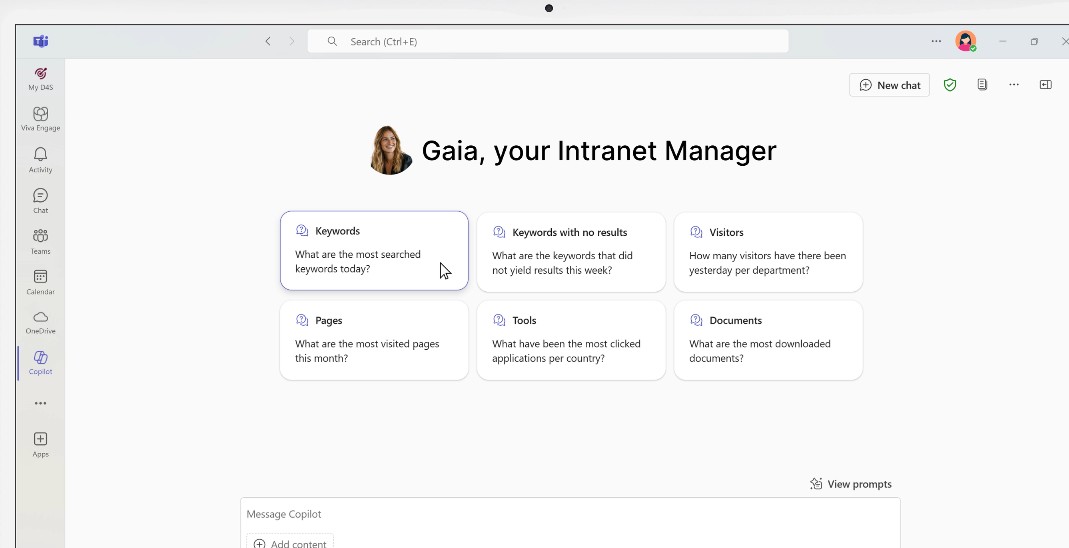
Overview of Gaia, the Intranet Manager from intranet.ai
The conversational interface is intuitive and accessible both from Microsoft Teams and via browser. With suggested commands or questions in natural language, users can receive advice and insights on how to reorganize content, resolve navigation issues, or optimize file categorization.
The multilingual support is also a strong advantage for international organizations, making communication easier between teams located in different offices. In these scenarios, being able to interact with an assistant in one’s native language is a competitive edge, as well as a great way to foster cohesion within the company.
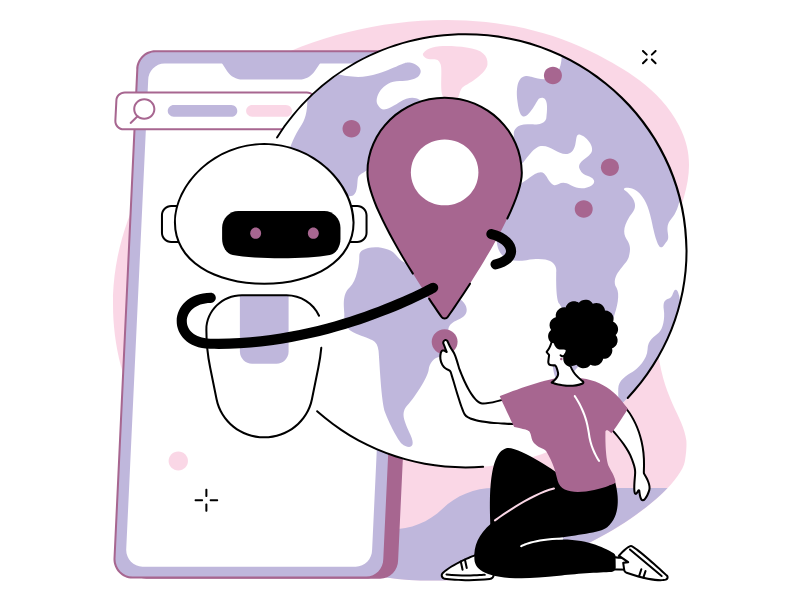
Digital transformation is not just about adopting new technologies, but about evolving the very way people relate to work.
Gaia becomes an ally that frees workers from the most repetitive tasks, allowing them to focus on higher-value activities. From personalized search to intranet traffic monitoring, everything is designed to build a digital workplace where every process is aligned with employees’ real needs.
Do you want a complete, ready-to-use intranet?
intranet.ai is the SharePoint Online-based solution for simplifying internal communication and digitizing business processes with minimal investment of time and money.
- 50+ features for communication and employee experience
- Branded design, customizable in every detail
- Full integration with Microsoft 365 and Viva
Giuseppe Marchi
Microsoft MVP for SharePoint and Microsoft 365 since 2010.
Giuseppe is the founder of intranet.ai and one of the top experts in Italy for all things Microsoft 365. For years, he has been helping companies build their digital workspace on Microsoft's cloud, curating the people experience.
He organizes monthly online events to update customers on what's new in Microsoft 365 and help them get the most out of their digital workplace.

FAQ about digital assistants for the intranet
What is a digital assistant for the intranet?
A digital assistant for the intranet is an AI-based software that operates within the company’s internal network. It helps staff interact with data and automate tasks, offering relevant answers thanks to natural language understanding and integration with corporate systems like SharePoint, Teams, and Outlook.
How is a digital assistant different from a chatbot?
A chatbot provides predefined responses based on a static knowledge base. A digital assistant, instead, understands the context of the request, accesses enterprise systems, and suggests concrete actions to improve daily work—offering a smarter, more personalized experience.
What are the benefits of a digital assistant in the intranet?
The digital assistant boosts productivity, reduces the time needed to find information, supports new hires during onboarding, automates repetitive tasks, and promotes digital culture within the company. It also simplifies processes and increases employee satisfaction.
Which tools does a digital assistant integrate with?
A digital assistant integrates with the Microsoft 365 ecosystem, including SharePoint Online, Outlook, Teams, and Power Automate. It can query data via Microsoft Graph API and use intelligent services like Azure Cognitive Services and Microsoft Mesh to offer a more interactive and contextual experience.
How can a digital assistant improve knowledge management?
The digital assistant analyzes user interactions, identifies recurring or missing content, and provides useful insights to optimize the knowledge base. This helps the company improve information quality, workflows, and training paths.
How is a digital assistant implemented in the intranet?
To implement a digital assistant, it is necessary to define clear objectives, analyze existing content, design an effective conversation flow, and test the solution with a pilot group. Colleague engagement, training, and usage data analysis are essential to ensure successful adoption.
Do you need new infrastructure to adopt a digital assistant?
No, not if the company already uses Microsoft 365. A digital assistant can be integrated without changing the existing infrastructure, thanks to preconfigured APIs and connectors that support modular management and progressive adoption of the technology.
Is a digital assistant secure in terms of privacy?
Yes, a digital assistant integrated with Microsoft 365 complies with the company’s security and compliance policies. It provides information only to authorized users and manages conversations in accordance with data protection regulations.
What is Gaia by intranet.ai?
Gaia is the digital assistant developed by intranet.ai to enhance SharePoint with advanced AI capabilities. It provides insights on navigation, analyzes user behavior, and suggests solutions to improve intranet usability. It’s accessible via Teams or browser, supports multiple languages, and is a true ally in managing the digital workplace.
Keep on reading
Microsoft 365 Copilot: What It Is, Pricing, and Features

Let’s see what Microsoft 365 Copilot is and why you should invest in it, one of the most powerful modern technologies to enhance daily productivity.
How to Create a SharePoint Intranet Site

Our experts share tips, considerations, and steps to follow to create a smart intranet site with Microsoft SharePoint.
